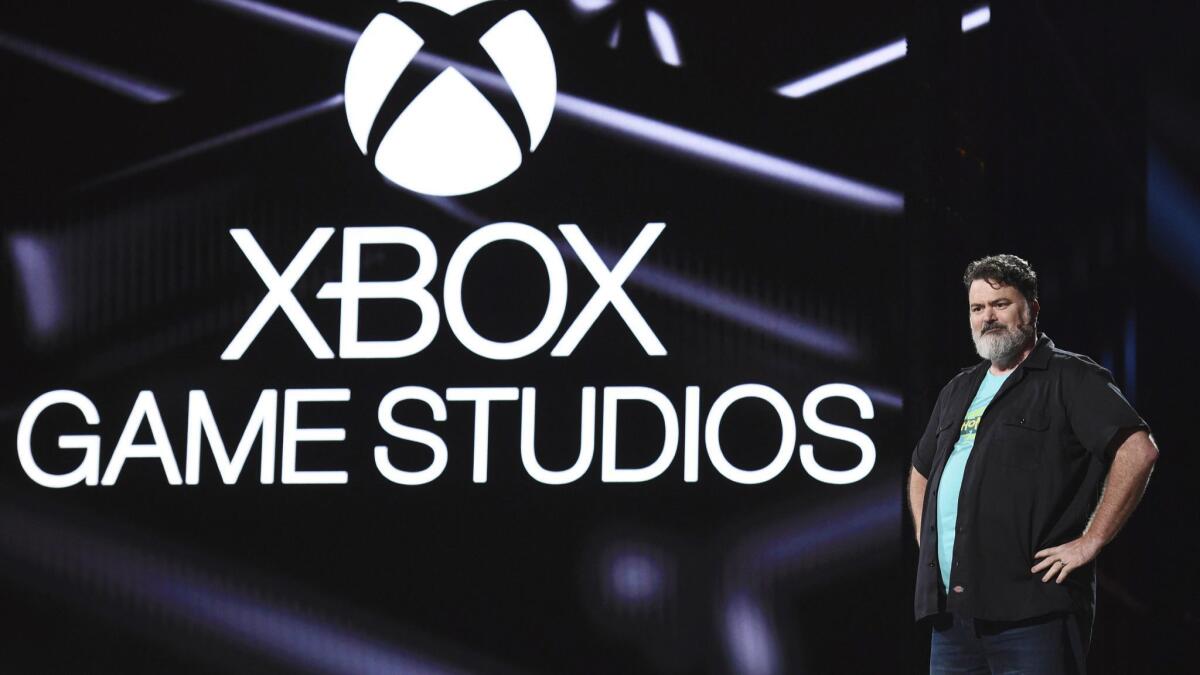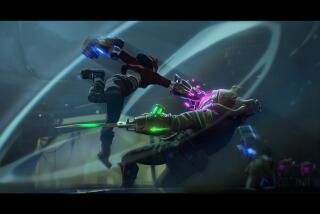Can streaming and subscription models do for games what they’ve done for TV?

- Share via
The struggle for Double Fine Presents to get the first “Psychonauts” released has become the stuff of modern game lore.
The game, a wacky exploration into various emotional mindsets, is now a cult classic with a sequel due in 2020. Yet the initial 2005 game was famously dropped by Microsoft, cut ostensibly because it was believed to be too weird for the Xbox game market, which was then and still is a place where big-budget action franchises such as “Halo” thrive.
“Humor,” read a critical Microsoft marketing document made for the first “Psychonauts,” “should be incorporated into the game as a secondary or supporting characteristic.” Double Fine founder Tim Schafer read the critiques aloud in “The Color of the Sky in Your World,” a multi-part online documentary released for the 10th anniversary of “Psychonauts.”
Among Microsoft’s other recommendations? Limit references to “summer camp.” Too American for a global audience.
What a difference a decade and a half make. As of earlier this year, Double Fine Presents, a Bay Area company that’s long been one of the most important champions of independent gaming in North America, is now a studio fully owned by Microsoft.
ALSO: ‘Neo Cab’ is the most perfect demo game I played at E3 2019. Here’s why »
Today, as gaming giants such as Microsoft, Sony, Google, Apple, Electronic Arts, Ubisoft and more look to subscription-based models — a shift that’s already remade the TV and music industries — Schafer believes Microsoft needs Double Fine as much as he desires financial stability for his company.
“When subscription services and other media start, they need not just content, but a diversity of content,” Schafer said in an interview earlier this month at the Double Fine booth on the E3 show floor. “There’s companies like Double Fine, but there’s not a lot of companies that make Double Fine-type games. And so I think it makes sense for them to acquire us, and the feeling that it makes sense is why I became OK with the idea because I wasn’t looking to get acquired.”
The technology-focused games medium is one where innovation thrives and new devices can instantly render old ones obsolete. But the gaming world can also be a bit stubborn in the type of content it releases, i.e., shooters. Yet if the rhetoric out of this year’s Electronic Entertainment Expo is to be believed, it’s time for some outreach.
Before the halls of the Los Angeles Convention Center even opened, when more than 66,000 people got a look at a number of the most anticipated upcoming games, the messaging from some of the major companies was clear: Games need to broaden beyond their core audience.
Ubisoft Chief Executive Yves Guillemot has repeatedly vowed to increase the number of global game players, from an estimated 2 billion now to 5 billion over the next decade. Electronic Arts, in promoting its subscription service, highlighted a commitment to broad, diverse indie content such as “Sea of Solitude,” a game about battling loneliness, and Microsoft has been bullish about its “gaming for everyone” initiative, efforts focused on broadening its developer roster and making its online communities more welcoming.
All are acknowledgments, in one way or another, that there are multiple barriers to entry in gaming, ranging from cost to inclusivity. “We love the capability of gaming. We love that it brings people together, but we also understand that it’s definitely not a perfect environment, and there’s work that we can do,” said Phil Spencer, who leads Microsoft’s Xbox division.
And yet if one were to judge the game industry solely by E3, both in what is shown in the large developer press conferences and given prominent display space on the show floor, one may notice a contradiction. With a few exceptions — Microsoft, for instance, highlighting “Psychonauts 2” and domestic indie thriller “12 Minutes” — one would see largely more of the same; that is, vast games with vague conspiratorial or dystopian plots and lots of violence.
No one not already in tune with the gaming world will be swayed by E3. “No,” agreed Pete Hines, a top marketing executive with Bethesda. “There’s no reason why you would expect that they would.”
But that may change, said Hines and other industry experts, as subscription models become the norm and streaming technology is finessed. The hope is that the ability to stream a game on, say, a smartphone, will make the medium more appealing to those who either don’t want or can’t afford a gaming set-up.
Add in what’s seen as an eventual shift to a subscription-driven market, and smaller, more indie-minded games could see additional players giving them a shot, in turn broadening the audience for less mainstream content.
Role-playing game “Moonlighter,” published by Polish indie studio 11Bit, sold about 500,000 copies, said the company’s Piotr Bajraszewski. “But still there’s a high potential to sell more,” he added. He hopes those who try the game via Electronic Arts’ subscription platform, with price tiers ranging from $4.99 to $14.99 per month, will eventually buy the game. But even if they don’t, he said, to avoid the network is to ignore “an additional channel to reach out to players.”
There’s still much to sort out. Google is pitching a streaming service that allows players to forgo owning a pricey PC or console while Microsoft, for now at least, is envisioning a near future in which its subscription-based Game Pass can tap into the streaming tech of xCloud to allow its players the freedom to play anywhere.
ALSO: ‘Cadence of Hyrule’ turns the kingdom of Zelda into a dance adventure »
There’s sure to be some confusion in the short term. Should a player link with Microsoft’s $9.99 Game Pass, Ubisoft’s $14.99 UPlay+, Google’s $9.99 Stadia, or a combination of multiple services in the same way a television fan may subscribe to Netflix for “Stranger Things,” Hulu for “The Handmaid’s Tale” and CBS All Access for “Star Trek: Discovery”?
While there’s some trepidation over how streaming will shake up a studio’s business model, the ultimate hope is that nonplayers will stop seeing “games” as one all-encompassing genre and discover the breadth of content available within the medium. One could argue that all three aforementioned shows exist, in large part, due to the growth of streaming services, and while it’s early, a once-dropped studio such as Double Fine is now seen as a vital piece to the Microsoft puzzle.
If consumers buy in, the video game industry, which long ago turned a plumber into a superhero, may start to get even odder. A studio, for instance, accustomed to largely taking big bets may readjust its own approach and go for more niche audiences.
“We have some big tentpole stuff that we do very well at $60, but a lot of games don’t,” said Todd Howard, Bethesda’s studio head. “There are certain types of games that people have kind of stopped making because it’s not going to sell X at $60. Well, maybe it doesn’t have to? Maybe it can go into a subscription service.”
More to Read
The biggest entertainment stories
Get our big stories about Hollywood, film, television, music, arts, culture and more right in your inbox as soon as they publish.
You may occasionally receive promotional content from the Los Angeles Times.











